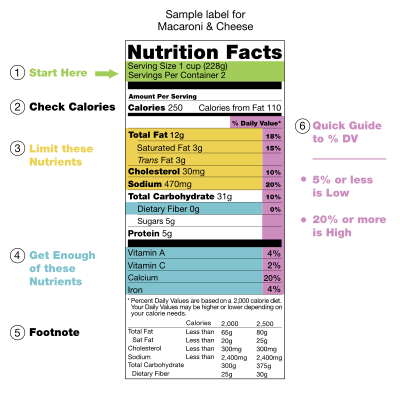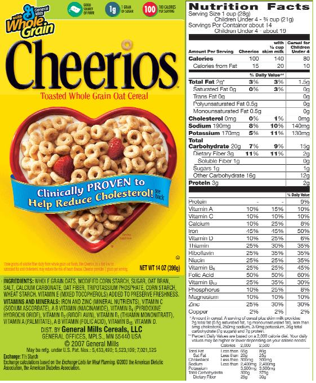Nutritional Labels
We have all seen them, and we have all seen the seemingly fit girl at the supermarket in workout shorts and running shoes read them and thought "look at her, counting calories...."
But what came next? Did you:
a) Look in to your shopping cart and start questioning the nutritional value of your items
b) Vow to start being more food conscious and pay attention to those labels...after this shopping trip (the pre-made lasagna looked too good to put back I'm sure. BEEN THERE!)
c) Move on without a second thought.
Honestly, I have done all three of those things. But I stopped putting off the change when I finally learned what each item on a food label meant, how to read and calculate the labels and what was good for me and my specific body type and goals.
Why are nutritional labels important?
The Journal of Agricultural Economics says that people who read the nutritional labels tend to be slimmer than those who do not, especially among women.
It is important to understand what is really in your food and what you are really eating and feeding to your family.
Not enough people are paying attention to the nutritional information on their food labels. According to a study conducted by the University of Minnesota's Health Sciences Department published in the Journal of American Diabetic Association 1/3 of people they always read the calorie counts on the label but in reality only 9% really do. And only 1% read the other components listed on the label that follow the calorie count (fats, sugars, serving size, carbohydrates, ect.).
Why read the nutritional labels?
All of this information can be very overwhelming but when taught how to read and understand what the information means, it can be a strong factor of change in your health.
If you have specific health concerns like allergies, high blood pressure, diabetes and other health issues, there are specific parts of the nutritional labels that will help you to find what your body needs or does not need more or less of.
How to read a nutritional label?
As with most things the most important information will be at the top. So start reading from the top of the label and work your way down, focusing most on the information that you read first.
Serving Size
The Serving Size is the base for the entire food label yet it is the most underrated of the information. If there are multiple servings in a bag multiply ALL of the factors by the number of servings.
The Serving Size for Cheerios is 1 cup with each serving containing 100 calories (without milk), 2g. total fat, 190mg of sodium and 3g. of protein.
If you consume 3 serving of Cherrios you will multiply all of these figures by 3.
100 calories x 3 = 300 calories
2g. total fat x 3 = 6g. total fat
190mg. sodium x 3 = 570mg. sodium
3g. protein x 3 = 9g. protein
Calories (and calories from fat)
When looking at the calories on a food label pay very close attention to the range the figure lands in...
40 calories = low calorie food
100 calories = moderate calorie food
400 calories = high colorie food
(Figures from the American Heart Association)
Factors for your daily consumption of calories are age, weight, gender and activity level. All food labels are based on a 2000 calorie diet. Your diet may be significantly less than that. Be sure to calculate your reccomended daily caloric intake by using tools such as the Calorie Calculator from the Mayo Clinic or by consulting with your physician.
Skip the calories from fat, base any nutritional decision on the dense nutritional information following calories and calories from fat on the food label.
Fat (Trans, Saturated and Total fats)
Contrary to most beliefs' there are good fats that are necessary in a daily diet. Think Heart-Healthy monosaturated and polysaturated fats that are found in fatty fish.
Due to the differences in healthy and unhealthy fats do not stress over the total fats line, focus on the amount of saturated fats are in the food and try to keep that number as low as posisble. These saturated fats raise cholesterol levels and increase the risk for heart disease and stroke.
The American Heart Association reccommends limiting the total saturated fats to 7% of total daily value which comes to 16 grams in a 2000 calorie diet.
Use the 5-20 rule:
5% daily value is low in between is moderate
20% daily value is high
Aim for 5% daily vaule of nutrients that you do not want in your body. Aim for 20% daily value of nutriets that you do want in your body.
According to Mayo Clinic Trans Fats are the big bad boys of fats, they fats raise LDL (bad cholesterol) and lower HDL (good cholesterol).
The Mayo Clinic also says that a label can say 0 trans fat and still contain .49g or less of trans fats. More than one serving can lead to more than the recommended daily value limits. When you see "partially hydrogenated" know there is trans fat in the food.
Cholesterol
Saturated fats are linked to your body's cholesterol level not cholesterol levels in food. Pay more attention to the amount of saturated fat than the amount of cholesterol.
In saying that, it is still important to keep your cholesterol low. Keep in mind the effect that trans fats have on cholesterol levels, don't raise the LDL levels and keep a healthy HDL level.
Cholesterol is only found in animal products and animal byproducts. Watch out for non-animal products that claim to be "cholesterol free" it's an empty claim.
Sodium
Recommended sodium intake is 2,300mg. The average sodium intake among Americans is 3,436mg, that's more than 1,000mg over the reccomended amount. (CDC)
Do not overlook the sodium levels! It is easy to skip over the amount of sodium and focus on calories and fat but the sodium can be really high in seemingly healthy foods.
The general population can use the 5-20 rule to determine the amount of sodium they should consume. There are special populations that should not consume more than 1,500mg of sodium:
According to Mayo Clinic Trans Fats are the big bad boys of fats, they fats raise LDL (bad cholesterol) and lower HDL (good cholesterol).
The Mayo Clinic also says that a label can say 0 trans fat and still contain .49g or less of trans fats. More than one serving can lead to more than the recommended daily value limits. When you see "partially hydrogenated" know there is trans fat in the food.
Cholesterol
Saturated fats are linked to your body's cholesterol level not cholesterol levels in food. Pay more attention to the amount of saturated fat than the amount of cholesterol.
In saying that, it is still important to keep your cholesterol low. Keep in mind the effect that trans fats have on cholesterol levels, don't raise the LDL levels and keep a healthy HDL level.
Cholesterol is only found in animal products and animal byproducts. Watch out for non-animal products that claim to be "cholesterol free" it's an empty claim.
Sodium
Recommended sodium intake is 2,300mg. The average sodium intake among Americans is 3,436mg, that's more than 1,000mg over the reccomended amount. (CDC)
Do not overlook the sodium levels! It is easy to skip over the amount of sodium and focus on calories and fat but the sodium can be really high in seemingly healthy foods.
The general population can use the 5-20 rule to determine the amount of sodium they should consume. There are special populations that should not consume more than 1,500mg of sodium:
- ages 51+
- African Americans
- high blood pressure patients
- diabetics
- chronic kidney disease patients
Complex carbohydrates (whole grains) are healthier than refined or simple carbohydrates.
Carbohydrates raise blood glucose levels--diabetics need to watch their carbohydrate intake.
Fiber
Importance: maintaining intestinal regularity and bowl health.
The USDA recommends 14 grams of fiber for every 1,000 calories per day.
Again, follow the 5-20 rule to help determine recommended daily fiber intake.
Here is a list of fiber rich foods.
Sugar
There is no recommended daily amount for sugar listed on food labels (FDA). The American Heart Association recommends keeping added sugar consumption to 6tsp a day for women and 9tsp for men. However the average American consumes 22tsp of sugar daily.
Do the Math
Each tsp of sugar is 4g. making the recommended amount for women 24g and for men 36g. (WebMD)
Natural Sugars can be found in fruits, milk and other dairy products. Products that have added sugar might not say sugar on the ingredients, look deeper in to the ingredients for key words like high fructose corn syrup, maltose or dextrose which are all different forms of added sugar. Here are common sugar disguises.
Protein
The CDC recommends 35% daily calories should be protein. 46g for women and 56g for men. It can be hard to know exactly how much protein is in a food because the FDA does not require the amount on the nutritional label.
Meat is not the only source of protein while it is the most well known. Here is a list of meat-free sources of protein.
Vitamins
Again use the 5-20 rule, aim for 20% for foods with Vitamin A, C, Calcium and Iron which make them a high source of that nutrient.
Vitamins are only expressed in percent daily value of nutritional labels try to get each one to add up to 100%. For example, if you are watching your calcium intake you can calculate the amount to mg by adding 0 to the percent of daily value. 15% of daily value of calcium = 150mg of calcium.
Typically we do not have shortages in Vitamin B such as riboflavin and thiamin. You don't have to worry about these as much unless you have been told by a physician that you are deficient in these nutrients.
********
Reading and understanding the nutritional labels on the foods that you are consuming is a great start to taking your health and nutrition in to you own hands. Pay attention to the numbers! To see the numbers on the scale and measurements get smaller, pay attention and take the time to read, evaluate and compare your food options based largely on your food's labels.




No comments:
Post a Comment